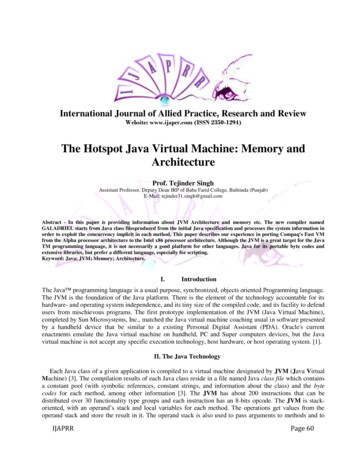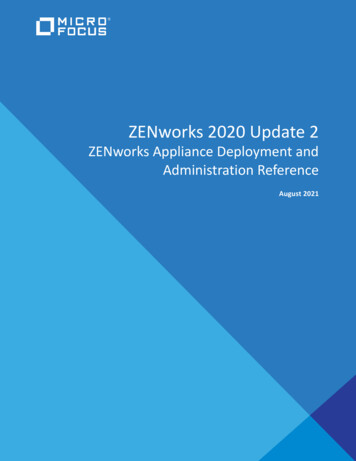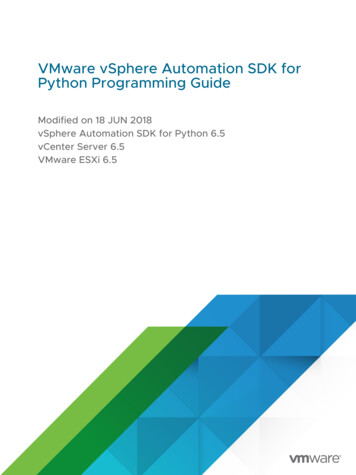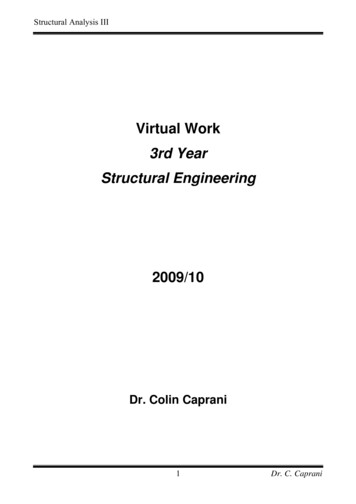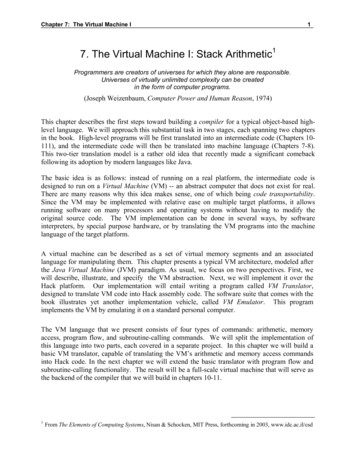
Transcription
Chapter 7: The Virtual Machine I17. The Virtual Machine I: Stack Arithmetic1Programmers are creators of universes for which they alone are responsible.Universes of virtually unlimited complexity can be createdin the form of computer programs.(Joseph Weizenbaum, Computer Power and Human Reason, 1974)This chapter describes the first steps toward building a compiler for a typical object-based highlevel language. We will approach this substantial task in two stages, each spanning two chaptersin the book. High-level programs will be first translated into an intermediate code (Chapters 10111), and the intermediate code will then be translated into machine language (Chapters 7-8).This two-tier translation model is a rather old idea that recently made a significant comebackfollowing its adoption by modern languages like Java.The basic idea is as follows: instead of running on a real platform, the intermediate code isdesigned to run on a Virtual Machine (VM) -- an abstract computer that does not exist for real.There are many reasons why this idea makes sense, one of which being code transportability.Since the VM may be implemented with relative ease on multiple target platforms, it allowsrunning software on many processors and operating systems without having to modify theoriginal source code. The VM implementation can be done in several ways, by softwareinterpreters, by special purpose hardware, or by translating the VM programs into the machinelanguage of the target platform.A virtual machine can be described as a set of virtual memory segments and an associatedlanguage for manipulating them. This chapter presents a typical VM architecture, modeled afterthe Java Virtual Machine (JVM) paradigm. As usual, we focus on two perspectives. First, wewill describe, illustrate, and specify the VM abstraction. Next, we will implement it over theHack platform. Our implementation will entail writing a program called VM Translator,designed to translate VM code into Hack assembly code. The software suite that comes with thebook illustrates yet another implementation vehicle, called VM Emulator. This programimplements the VM by emulating it on a standard personal computer.The VM language that we present consists of four types of commands: arithmetic, memoryaccess, program flow, and subroutine-calling commands. We will split the implementation ofthis language into two parts, each covered in a separate project. In this chapter we will build abasic VM translator, capable of translating the VM’s arithmetic and memory access commandsinto Hack code. In the next chapter we will extend the basic translator with program flow andsubroutine-calling functionality. The result will be a full-scale virtual machine that will serve asthe backend of the compiler that we will build in chapters 10-11.1From The Elements of Computing Systems, Nisan & Schocken, MIT Press, forthcoming in 2003, www.idc.ac.il/csd
Chapter 7: The Virtual Machine I2The virtual machine that will emerge from this effort illustrates many important ideas incomputer science. First, the notion of having one computer emulating another is a fundamentalidea in the field, tracing back to Alan Turing in the 1930’s. Over the years it had many practicalimplications, e.g. using an emulator of an old generation computer running on a new platform inorder to achieve upward code compatibility. More recently, the virtual machine model becamethe centerpiece of two well-known mainstreams -- the Java architecture and the .NETinfrastructure. These software environments are rather complex, and one way to gain an insideview of their underlying structure is to build a simple version of their VM cores, as we do here.Another important topic embedded in this chapter is stack processing. The stack is a fundamentaldata structure that comes to play in many computer systems and algorithms. In particular, theVM presented in this chapter is stack-based, providing a working example of the elegance andpower of this remarkably versatile data structure. As the chapter unfolds we will describe andillustrate many classical stack operations, and then implement them in our VM translator.1. BackgroundThe Virtual Machine ParadigmBefore a high-level program can run on a target computer, it must be translated into thecomputer’s machine language. This translation -- known as compilation -- is a rather complexprocess. Normally, a separate compiler is written specifically for any given pair of high-levellanguage and target machine language. This leads to a proliferation of many different compilers,each depending on every detail of both its source and destination languages. One way todecouple this dependency is to break the overall compilation process into two nearly separatestages. In the first stage, the high-level program is parsed and its commands are translated into“primitive” steps -- steps that are neither “high” nor “low”. In the second stage, the primitivesteps are actually implemented in the machine language of the target hardware.This decomposition is very appealing from a software engineering perspective: the first stagedepends only on the specifics of the source high-level language, and the second stage only on thespecifics of the target machine language. Of course, the interface between the two compilationstages -- the exact definition of the intermediate primitive steps -- must be carefully designed. Infact, this interface is sufficiently important to merit its own definition as a stand-alone languageof an abstract machine. Specifically, one formulates a virtual machine whose instructions are theprimitive steps into which high-level commands are decomposed. The compiler that wasformerly a single monolithic program is now split into two separate programs. The first program,still termed compiler, translates the high-level code into intermediate virtual machineinstructions, while the second program translates this VM code into the machine language of thetarget platform.This two-stage compilation model has been used by many compiler writers, in one way oranother. Some developers went as far as defining a formal virtual machine language, mostnotably the p-code generated by several Pascal compilers in the 1970s and the bytecode languagegenerated by Java compilers. More recently, the approach has been adopted by Microsoft, whose.NET infrastructure is also based on an intermediate language, running on a virtual machinecalled CLR.
Chapter 7: The Virtual Machine I3Indeed, the notion of an explicit and formal virtual machine language has several practicaladvantages. First, compilers for different target platforms can be obtained with relative ease byreplacing only the virtual machine implementation (sometimes called the compiler’s “backend”).This, in turn, allows the VM code to become transportable across different hardware platforms,permitting a range of implementation tradeoffs between code efficiency, hardware cost, andprogramming effort. Second, compilers for many languages can share the same VM “backend”,allowing code re-use and language inter-operability. For example, some high-level languagesare good at handling the GUI, while others excel in scientific calculations. If both languagescompile into a common VM language, it is rather natural to have routines in one language callroutines in the other, using an agreed-upon invocation syntax.Another virtue of the virtual machine approach is modularity. Every improvement in theefficiency of the VM implementation is immediately inherited by all the compilers above it.Likewise, every new digital device or appliance which is equipped with a VM implementationcan immediately gain access to a huge base of available software.high levellanguage 1.Jacklanguage 1compilerJackcompiler.high levellanguage nlanguage ncompilerChapters10-11VM languageVMimplementationfor CISCplatformsCISCprogramVM imp.for RISCplatforms.RISCprogram.CISCmachineVM imp.for en in somehigh levellanguage.other digital devices and appliances, eachRISCmachine equipped with its own VM implementationHackcomputeranyplatformFIGURE 1: The virtual machine paradigm. Once a high-level program is compiled into VM code,the program can run on any hardware platform equipped with a suitable VM implementation. Inthis chapter we will start building the VM implementation on the Hack Platform, and use a VMemulator like the one depicted on the right. (The Jack language is introduced in chapter 9).
Chapter 7: The Virtual Machine I4The Stack Machine ModelA virtual machine can be described as a set of virtual memory segments and an associatedlanguage for manipulating them. Like other languages, the VM language consists of arithmetic,memory access, program flow, and subroutine calling operations. There are several possiblesoftware paradigms on which to base such a virtual machine architecture. One of the keyquestions regarding this choice is where will the operands and the results of the VM operationsreside? Perhaps the cleanest solution is to put them on a stack data structure.In a stack machine model, arithmetic commands pop their operands from the top of the stack andpush their results back onto the top of the stack. Other commands transfer data items from thestack's top to designated memory locations, and vice versa. Taken together, these simple stackoperations can be used to implement the evaluation of any arithmetic or logical expression.Further, any program, written in any programming language, can be translated into an equivalentstack machine program. One such stack machine model is used in the Java Virtual Machine aswell as in the VM described and built in this chapter.Elementary Stack Operations: A stack is an abstract data structure that supports two basicoperations: push and pop. The push operation adds an element to the “top” of the stack; theelement that was previously on top is pushed “below” the newly added element. The popoperation retrieves and removes the top element; the element just “below” it moves up to the topposition. Thus the stack implements a last-in-first-out (LIFO) storage model. This basic anatomyis illustrated in Figure 2.stackmemory121a517bSP.memorystack.6push Pa5(before)5.121b.1216108.memorypop a5aSPb.17108.FIGURE 2: Stack processing example, illustrating the two elementary operations push and pop.Following convention, the stack is drawn upside down, as if it grows downward. The location justafter the top position is always referred to by a special pointer called sp, or stack pointer. Thelabels a and b refer to two arbitrary memory addresses.
Chapter 7: The Virtual Machine I5We see that stack access differs from conventional memory access in several respects. First, thestack is accessible only from the top, one item at a time. Second, reading the stack is a lossyoperation: the only way to retrieve the top value is to remove it from the stack. In contrast, theact of reading a value from a regular memory location has no impact on the memory’s state.Finally, writing an item onto the stack adds it to the stack’s top, without changing the rest of thestack. In contrast, writing an item into a regular memory location is a lossy operation, since iterases the location’s previous value.The stack data structure can be implemented in several different ways. The simplest approach isto keep an array, say stack, and a stack pointer variable, say sp, that points to the availablelocation just above the “topmost” element. The push x command is then implemented by storingx at the array entry pointed by sp and then incrementing sp (i.e. stack[sp] x; sp sp 1). Thepop operation is implemented by first decrementing sp and then returning the value stored in thetop position (i.e. sp sp-1; return stack[sp]).As usual in computer science, simplicity and elegance imply power of expression. The simplestack model is an extremely useful data structure that comes to play in many computer systemsand algorithms. In the virtual machine architecture it serves two main purposes. First, it is usedfor handling all the arithmetic and logical operations of the VM. Second, it facilitates functioncalls and dynamic memory allocation -- the subjects of the next chapter.Stack Arithmetic: Stack-based arithmetic is a simple matter: the two top elements are poppedfrom the stack, the required operation is performed on them, and the result is pushed back ontothe stack. For example, here is how addition is handled:171745 9SPSPIt turns out that every arithmetic expression -- no matter how complex -- can be easily convertedinto, and evaluated by, a sequence of simple operations on a stack. For example, consider theexpression d (6–4)*(8 1), taken from some high-level program. The stack-based evaluationof this expression is shown in Figure 3.
Chapter 7: The Virtual Machine ISP66push 6-6push 44SPSPpush 6push 4-2push 8push 12push 8SP2push 18SP * 81SPpop dmemory218*9pop dSP.SPdSP.18FIGURE 3: Stack-based evaluation of arithmetic expressions.This example evaluates the expression “d (6–4)*(8 1)”In a similar fashion, every logical expression can also be converted into, and evaluated by, asequence of simple stack operations. For example, consider the high-level command “if (x 7)or (y 8) then ”. The stack-based evaluation of this expression is shown in Figure 4.memory.SPpushpush pushpush Or12xx7yy8127push x. 12push 7SP8falsefalsepush ySP8push 8SPSPfalse8false gicalexpressions.This example evaluates the expression “if (x 7) or (y 8) then .”To sum up, the above examples illustrate a general observation: any arithmetic and Booleanexpression can be transformed into a series of elementary stack operations that compute its value.Further, as we will show in Chapter 9, this transformation can be described systematically. Thus,
Chapter 7: The Virtual Machine I7one can write a compiler program that translates high-level arithmetic and Boolean expressionsinto sequences of stack commands. Yet in this chapter we are not interested in the compilationprocess, but rather in its results – i.e. the VM commands that it generates. We now turn tospecify these commands (section 2), illustrate them in action (section 3), and describe theirimplementation on the Hack platform (section 4).2. VM Specification, Part I2.1 GeneralThe virtual machine is stack-based: all operations are done on a stack. It is also function-based: acomplete VM program is composed of a collection of functions, written in the VM language.Each function has its own stand-alone code and is separately handled. The VM language has asingle 16-bit data type that can be used as an integer, a Boolean, or a pointer. The languageconsists of four types of commands:Arithmetic commands perform arithmetic and logical operations on the stack;Memory access commands transfer data between the stack and virtual memory segments;Program flow commands facilitate conditional and unconditional branching operations;Function calling commands call functions and return from them.Building a virtual machine is a complex undertaking, and so we divide it into two stages. In thischapter we specify the arithmetic and memory access commands, and build a basic VM translatorthat implements them only. The next chapter specifies the program flow and function callingcommands, and extends the basic translator into a full-blown virtual machine implementation.Program and command structure: A VM program is a collection of one or more files with a.vm extension, each consisting of one or more functions. From a compilation standpoint, theseconstructs correspond, respectively, to the notions of program, class, and method in an objectoriented language.Within a .vm file, each VM command appears in a separate line, and in one of the followingformats: command , command arg , or command arg1 arg2 , where the arguments areseparated from each other and from the command part by an arbitrary number of spaces. “//”comments can appear at the end of any line and are ignored. Blank lines are permitted.
Chapter 7: The Virtual Machine I82.2 Arithmetic and logical commandsThe VM language features nine stack-oriented arithmetic and logical commands. Seven of thesecommands are binary: they pop two items off the stack, compute a binary function on them, andpush the result back onto the stack. The remaining two commands are unary: they pop a singleitem off the stack, compute a unary function on it, and push the result back onto the stack. Wesee that each command has the net impact of replacing its operand(s) with the command's result,without affecting the rest of the stack. Table 5 gives the details.CommandReturn value (after popping the operand/s) Commentaddx yinteger addition(2's complement)subx-yinteger subtraction(2's complement)neg–yarithmetic negation(2's complement)eqtrue if x y and false otherwiseequalitygttrue if x y and false otherwisegreater thanlttrue if x y and false otherwiseless thanandx and ybit-wiseorx or ybit-wisenotnot ybit-wise.xySPTABLE 5: Arithmetic and Logical stack commands. Throughout the table, y refers tothe item at the top of the stack and x refers to the item just below it.Three of the commands listed in Table 5 (eq, gt, lt) return Boolean values. The VM representstrue and false as -1 (minus one, 0xFFFF) and 0 (zero, 0x0000), respectively.
Chapter 7: The Virtual Machine I9Example: Figure 6 illustrates all the VM arithmetic commands in action. Each command isapplied to an arbitrary 4-bit stack, showing the stack's state before and after the operation. Wefocus on the three top-most cells in the stack, noting that the rest of the stack is never affected bythe current 0SPSPFIGURE 6: Arithmetic commands examples.2.3 Memory Access CommandsUnlike real computer architectures, where the term “memory” refers to a collection of physicalstorage devices, the “memory” of a virtual machine consists of abstract devices. In particular, theVM manipulates eight memory segments, listed in Table 7. VM functions can access thesememory segments explicitly, using VM commands. In addition, the VM manages the stack, butonly implicitly. In other words, although the stack proper is not mentioned in VM commands,the state of the stack changes in the background, as a side effect of other commands.
Chapter 7: The Virtual Machine I10Another memory element that exists in the background is the heap. As we elaborate later in thechapter, the heap is an area in the physical RAM where objects and arrays are stored. Theseobjects and arrays can also be manipulated by VM commands, as we will see shortly.Memory Segments: Each VM function sees the eight memory segments described in Table 7.SegmentPurposeCommentsargumentStores the function’s arguments.Allocated dynamically by the VMimplementation when the function is entered.localStores the function’s local variables.Allocated dynamically by the VMimplementation when the function is entered.staticStores static variables shared by allfunctions in the same .vm file.Allocated by the VM implementation foreach file; Seen by all functions in the file.constantPseudo-segment that holds all theconstants in the range 0.32767.Emulated by the VM implementation;Seen by all the functions in the program.thisthatGeneral-purpose segments that can bemade to correspond to different areas inthe heap. Serve various programmingneeds.Any VM function can bind these segments toany area on the heap by setting the segment’sbase. The setting of the segment’s base isdone through the pointer segment.pointerFixed 2-entry segment that holds the baseaddresses of this and that.May be set by the VM program to bind thisand that to various areas in the heap.tempFixed 8-entry segment that holdstemporary variables for general use.May be used by the VM program for anypurpose.TABLE 7: The memory segments seen by every VM function.Six of the virtual memory segments have a fixed purpose, and their mapping onto the host RAMis controlled by the VM implementation. In contrast, the this and that segments are generalpurpose and their mapping on the host RAM can be controlled by the current VM program:pointer 0 controls the base of the this segment and pointer 1 controls the base of thethat segment.Memory access commands: There are two memory access commands: push segment indexpush the value of segment[index] onto the stack; pop segment indexpop the topmost stack item and store its value in segment[index].Where segment is one of the eight segment names and index is a non-negative integer.
Chapter 7: The Virtual Machine I11The stack: Consider the commands sequence “push argument 2” followed by “pop localrdnd1”. This code will end up storing the value of the function’s 3 argument in its 2 local variable(each segment’s index starts at 0). The working memory of these commands is the stack: thedata value did not simply jump from one segment to another -- it went through the stack. Yet inspite of its central role in the VM architecture, the stack proper is never mentioned in the VMlanguage. In addition, although every memory access operation involves the stack, individualstack elements cannot be accessed directly, except for the topmost element.2.4 Program flow commands label symbol// label declaration goto symbol// unconditional branching if-goto symbol// conditional branchingThese commands are discussed in the next chapter, and are listed here for completeness.2.5 Function calling commands function functionName nLocals// function declaration; must include// the number of the function’s local variables call functionName nArgs// function invocation; must include// the number of the function’s arguments return// transfer control back to the calling functionWhere functionName is a symbol and nLocals and nArgs are non-negative integers. Thesecommands are discussed in the next chapter, and are listed here for completeness.2.6 The big pictureWe end the first part of the VM specification with a “big picture” view of the overall translationprocess, from a high-level program into machine code. At the top of Figure 9 we see a Jackprogram, consisting of two classes (Jack is a Java-like language that will be introduced in chapter9). Each class consists of several methods. When the Jack compiler is applied to the directory inwhich these classes reside, it produces two VM files. In particular, each method in the high-levelsource code translates into one function at the VM level.Next, the figure shows how the VM Translator can be applied to the directory in which the VMfiles reside, generating a single assembly program. This low-level program does two mainthings. First, it emulates all the virtual memory segments shown in the figure, as well as theimplicit stack. Second, it effects the VM commands on the target platform. This is done bymanipulating the emulated VM data structures using machine language instructions. Ifeverything works well, i.e. if the compiler and the VM translator are implemented correctly, thetarget platform will end up effecting the behavior mandated by the original Jack program.
Chapter 7: The Virtual Machine I12prog .vmf2(m methods)(chapters 9-10)prog directoryf1Jack classesm1f3f1f2VM files(f functions)VMtranslatorvirtual memory terpointer(one set foreach instanceof a ck assembly codeFIGURE 9: VM translation: the big picture.machinelanguageprogram
Chapter 7: The Virtual Machine I133. VM Programming ExamplesWe now turn to illustrate the VM architecture, language, and programming style in action. Wegive three examples: (i) a typical arithmetic task, (ii) typical handling of object fields, and (iii)typical handling of array elements.It’s important to note at the outset that VM programs are rarely written by human programmers,but rather by compilers. Therefore, it is instructive to begin each example with a high-levelversion of the program, and then track down its translation it into VM code. We use a C-stylesyntax for all the high-level examples.3.1 A Typical Arithmetic TaskConsider the multiplication algorithm shown at the top of Program 10. How should we (or morelikely, the compiler) express this algorithm in the VM language? Well, given the primitive natureof the VM commands, we must think in terms of simple "goto logic," resulting in the “firstapproximation” version of Program 10. Next, we have to express this logic using a stack-orientedformalism. It is instructive to carry out this translation in two stages, beginning with a symbolicpseudo version of the VM language. Finally, we replace the symbols in the pseudo code withvirtual memory locations, leading to the actual VM program. (The exact semantics of the VMcommands function, label, goto, if-goto, and return are described in chapter 8, but theirintuitive meaning is self-explanatory.)
Chapter 7: The Virtual Machine I14High-Level Code (C style)int mult(int x,int y) {int sum,j;sum 0;for(int j y; j! 0; j--)sum x;// repetitive additionreturn sum;}First approximationPseudo VM codeFinal VM codefunction multfunction mult(x,y)function mult 2args x,ypush 0push constant 0vars sum,jpop sumpop local 0sum 0push ypush argument 1j ypop jpop local 1loop:label loop// sum 0// j ylabel loopif j 0 goto endpush 0push constant 0sum sum xpush jpush local 1j j-1eqeqgoto loopif-goto endif-goto endpush sumpush local 0push xpush argument 0addaddpop sumpop local 0push jpush local 1push 1push constant 1subsubpop jpop local 1end:return sumgoto loopargument12.// j j-1// return sumreturnRun-time example: Just after mult(7,3) is entered:0// sum sum xlabel endpush local 0returnSP// if j 0 goto endgoto looplabel endpush sumstackJust before mult(7,3) returns:stacklocal7x3y// 2 local variables0120sum0j21SP.(The symbols x,y,sum,j are not part of the VM! They are shown here only for ease of reference)PROGRAM 10: VM programming example.
Chapter 7: The Virtual Machine I15We end this example with two observations. First, let us focus on the figure at the bottom ofProgram 10. We see that when a VM function starts running, it assumes that (i) the stack isempty, (ii) the argument values on which it is supposed to operate are located in the argumentsegment, and (iii) the local variables that it is supposed to use are initialized to 0 and located inthe local segment. Second, let us focus on the translation from the pseudo code to the finalcode. Recall that VM commands are not allowed to use symbolic argument and variable names - they are limited to making segment index references only. However, the translation from theformer to the latter is straightforward. All we have to do is represent x, y, sum and j asargument 0, argument 1, local 0 and local 1, respectively, and replace all theirsymbolic occurrences in the pseudo code with corresponding segment index references.To sum up, when a VM function starts running, it assumes that it is surrounded by a privateworld, all of its own, consisting of initialized argument and local segments and an emptystack, waiting to be manipulated by its commands. The agent responsible for building this worldfor every VM function just before it starts running is the VM implementation, as we will see inthe next chapter.3.2 Object handlingHigh-level object-oriented programming languages are designed to handle complex variablescalled objects. Technically speaking, an object is a bundle of variables (also called fields, orproperties), with associated code, that can be treated as one entity. For example, consider ananimation program designed to juggle balls on the screen. Suppose that each Ball object ischaracterized by the integer fields x, y, radius, and color. Let us assume that the program hascreated one such Ball object, and called it b. What will be the internal representation of thisobject in the computer?Like all other objects, it will end up on an area in the RAM called heap. In particular, whenevera program creates a new object using a high-level command like b new Ball(.), thecompiler computes the object's size (in terms of words) and the operating system finds andallocates enough RAM space to store it in the heap. The details of memory allocation and deallocation will be discussed later in the book. For now, let us assume that our b object has beenallocated RAM addresses 3012 to 3015, as shown in Program 11.Suppose now that a certain function in the high-level program, say resize, takes a Ball objectand an integer r as arguments, and, among other things, sets the ball's radius to r. The functionand its VM translation are given in Program 11.
Chapter 7: The Virtual Machine I16RAM viewHigh level program view0b new ation80503(by the compilerand the O/S)High-level code.301219.30121203013803014503015.b.radius r;.push argument 0pop pointer 0push argument 1pop this 2.}Run-time simulation (example):stackb object3VM code// b.radius rresize (Ball b,int r) {SP.(The RAM locationsof the b pointer andthe b object arearbitrary examples.)poppush// get b's base address// point the this segment to b// get r's value// set b's third field to rJust after resize(b,17) is entered:argumentthispointer03012001171122.Just after setting b's radius to 01201203012180301321730143703015PROGRAM 11: VM-based object manipulation. (The labels at the bottom right(3012, .) are not part of the VM state,
stack machine program. One such stack machine model is used in the Java Virtual Machine as well as in the VM described and built in this chapter. Elementary Stack Operations: A stack is an abstract data structure that supports two basic operations: push and pop. The push operation adds an element to the "top" of the stack; the




